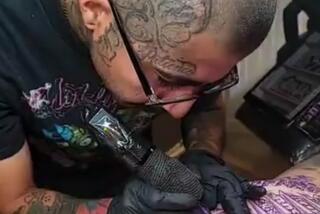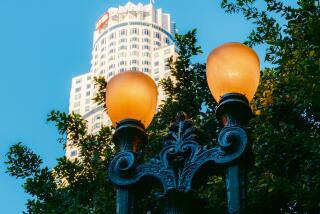Douglas Leigh; Kept Times Square Aglow With Illuminated Advertising Signs
- Share via
When the glittering ball drops on Times Square to usher in the new millennium, Douglas Leigh will probably turn in his grave to get a better view.
Leigh was the lamplighter of Broadway, an impresario of illuminated signs who once owned 1 Times Square, the building where the ball is dropped every New Year’s Eve. He turned the property into a showcase for blindingly lit signs, a fitting monument to the life work of a man whose advertising brainstorms produced spectacular displays along one of the world’s most famous streets.
“From the beginning of time, darkness has brought on fear,” Leigh once said. “Lighting lifts the spirits.”
Starting in the 1930s, Leigh began to lift spirits--and make a small fortune along the way. To pitch A & P coffee, he erected a giant, electrically lighted coffee cup with real steam wafting from pipes along the rim. To sell Camel cigarettes, he built a sign featuring three huge glowing smoke rings. To market Pepsi-Cola, he conceived of a megawatt waterfall that circulated 50,000 gallons of fake soda a minute. To entice potential buyers of Super Suds detergent, he set a sign ablaze with 3,000 blinking soap bubbles.
Leigh decorated Broadway with his gaudy creations for 43 years. Then, in 1976 when he was “pushing 70,” he decided to flip a new switch. In his second career, he devoted himself to the illumination of buildings, including such landmarks of the New York skyline as the Empire State Building, the Helmsley Building and the Waldorf-Astoria. The nonagenarian was still going strong last year, when he designed a lighting scheme for a Donald Trump tower on Wall Street.
“I’m not an engineer. I’m not an artist. I’m not a technician. I’m an idea man, a concept guy,” said Leigh, who died Dec. 14 in a Manhattan hospital, having outlived many of his legendary light projects. He was 92.
Millions of New York residents and tourists have gawked at the sparks of his imagination. He helped give the city “an entire nighttime identity,” New York Times architecture critic Paul Goldberger once wrote.
Leigh had a moth-like fascination with the light bulb. “I have always been fascinated by bright lights,” he told E.J. Kahn Jr., who wrote a lengthy profile of the electric sign king in the New Yorker in 1941. Kahn observed that “if New York City is ever thoroughly blacked out, no man will take it harder.”
When Leigh was 31, he had already built 16 signs along Broadway, five of which Kahn described as among the gaudiest in Times Square. He described Leigh as unimposing, “a gentle zephyr” who had only two physical characteristics that were “even remotely impressive”: Leigh always wore a fresh boutonniere and a bow tie. Kahn noted that Leigh owned 43 bow ties.
He was born in Anniston, Ala., the son of a banker who afforded his family a comfortable life. Nonetheless, the young Leigh was exhaustingly entrepreneurial. Kahn wrote that during a brief college career at the University of Florida in Gainesville, Leigh earned more than his professors by selling college yearbook ads, fraternity pins, alligator skin belts, pennants and other paraphernalia.
In 1927, he left college and worked for a couple of sign companies, one in Atlanta and one in Brooklyn, but felt stifled by their narrow “poster and paint” vision of signs. So on March 4, 1933, the day after President Franklin D. Roosevelt’s inauguration, he officially struck out on his own.
Broadway already had some big electric signs by then. Leigh, according to Kahn, decided to count the number of bulbs in them and arrived at the sum of 90,500. In Leigh’s estimation, that was not enough. His solution was the steaming coffee cup, which would be 15 feet in diameter. He sold the idea to the Atlantic & Pacific grocery chain and mounted the display above Broadway and 47th Street in late 1933.
Within a few years, Times Square was aglow with his creations--a twinkling penguin for Kool cigarettes, a clown tossing three neon rings in the shape of the Ballantine beer and ale logo, and an animated cartoon for Wilson whiskey. By 1938, he had more than $1 million in sign contracts.
During World War II, his signs went dark in the blackout. Leigh may have taken it hard, but he kept going by promoting war bonds and lending his knowledge of lighting and projection to the Navy for gunnery training. When the war ended, he bought surplus dirigibles and sent them aloft emblazoned with ad slogans.
His second career was launched when Harry Helmsley approached him to design lighting for the Empire State Building for the 1976 bicentennial. He bathed the tower in red, white and blue light, inaugurating a tradition of multihued lighting for special occasions. Leigh went on to design lighting master plans for entire cities, including Atlanta and Cincinnati.
But while he relished the task of “delivering pure light to glorify a beautiful building,” he still dabbled in electric signs. In 1984, he strung together 6,000 tiny bulbs in the shape of a snowflake 2 1/2 stories high and suspended it over the middle of 57th Street and 5th Avenue. Hanging between Tiffany and the Bergdorf-Goodman department store, the holiday decoration sparked debate. Goldberger, the architecture critic for the New York Times, called it “bulbous . . . and not a little grotesque.” Theater critic and civic booster Brendan Gill pronounced it “a joyful idiocy.”
Over the decades, Leigh’s luminous urban displays had stirred mixed reactions. Kahn, for instance, wryly noted in 1941 that Leigh “thinks of his creations as works of art, which is probably the way postcard men feel about postcards.”
Whether it was kitsch or culture, Leigh probably summed up his efforts best. “If we took the bright lights off Broadway,” he once wrote, “it would no longer be the throbbing heart that typifies America’s gay spirits.”
More to Read
The biggest entertainment stories
Get our big stories about Hollywood, film, television, music, arts, culture and more right in your inbox as soon as they publish.
You may occasionally receive promotional content from the Los Angeles Times.











